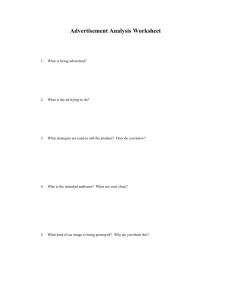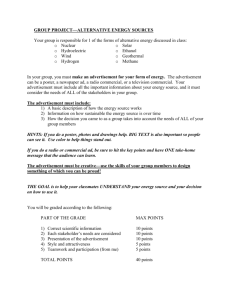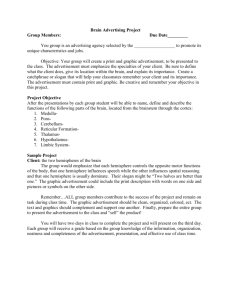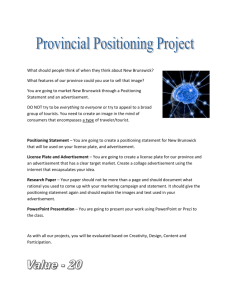Summative com tec
advertisement
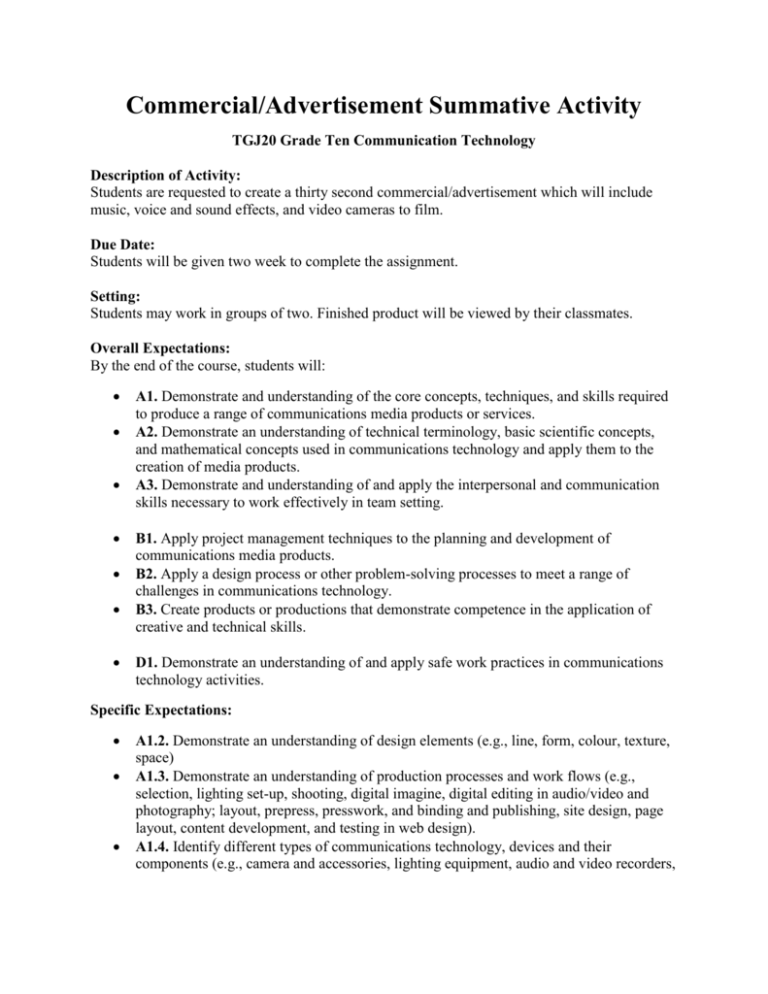
Commercial/Advertisement Summative Activity TGJ20 Grade Ten Communication Technology Description of Activity: Students are requested to create a thirty second commercial/advertisement which will include music, voice and sound effects, and video cameras to film. Due Date: Students will be given two week to complete the assignment. Setting: Students may work in groups of two. Finished product will be viewed by their classmates. Overall Expectations: By the end of the course, students will: A1. Demonstrate and understanding of the core concepts, techniques, and skills required to produce a range of communications media products or services. A2. Demonstrate an understanding of technical terminology, basic scientific concepts, and mathematical concepts used in communications technology and apply them to the creation of media products. A3. Demonstrate and understanding of and apply the interpersonal and communication skills necessary to work effectively in team setting. B1. Apply project management techniques to the planning and development of communications media products. B2. Apply a design process or other problem-solving processes to meet a range of challenges in communications technology. B3. Create products or productions that demonstrate competence in the application of creative and technical skills. D1. Demonstrate an understanding of and apply safe work practices in communications technology activities. Specific Expectations: A1.2. Demonstrate an understanding of design elements (e.g., line, form, colour, texture, space) A1.3. Demonstrate an understanding of production processes and work flows (e.g., selection, lighting set-up, shooting, digital imagine, digital editing in audio/video and photography; layout, prepress, presswork, and binding and publishing, site design, page layout, content development, and testing in web design). A1.4. Identify different types of communications technology, devices and their components (e.g., camera and accessories, lighting equipment, audio and video recorders, audio mixes, scanners, printing equipment), and explain how they are used to produce communications products and services. A1.5 Identify the different types of communications software used to create communications technology products and services (e.g., software for photo, audio and video editing, animation, page layout, web design creations, and computer graphics), and describe how they are used. A2.1 Demonstrate an understanding of communication technology terms, and use them correctly in oral and written communication (e.g., composition, contrast, scene, typography, layout, story board, clip, fade, dissolve, levels, layers, SFX, filters, timeline, site map, navigation). A3.2 Describe and use techniques that encourage participation by all members of a team (e.g., brain storming, group discussion, celebration of others, thoughts or contributions, acceptance of cultural differences). B3.1 Apply creative skills, equipment operating skills, and software skills to create components for a media production (e.g., text, video footage, voice overs, graphics, and animation for a video promoting a school event). D1.2 Apply safe work practices when performing communication technology tasks (e.g., use of ergonomically designed equipment, keep work area tidy, avoid eye strain, use moderate volume levels). Strategies to Enhance Student Learning: Use of rubrics for self-assessment Allow students choices, let student brain storm ideas (what commercials they would like to produce (personalize). Make the assignments competition based (prize for the best product). Extend the learning environment beyond the classroom. Incorporate music in the classroom (allow students to listen to music while they are doing seat work). Prior Knowledge Safe operation of video camera and audio equipment. Creation of story boards. Familiarity with terminology. Use of software (Imovie, Movie Maker). Ability to edit. Setting up the production (pre, production, post). Planning and design. Assessment techniques to be used: Rubric. Anecdotal notes to be taken by teacher. Daily log sheets. Finished product. Used of “TACK”. Instructional Strategies Demonstrations of equipment by the teacher (exemplars). Tutorials on use of video and audio equipment. Allowing students to practice. Brain storming and anticipation guide questions. Ongoing feed-back. Knowledge/Understanding. Accommodations/Modifications: The teacher will follow the students IEP as per instructions (accommodations). Teacher may also make modifications for students within the classroom as noted in the lesson plan. Learning Goals: The student will learn to identify, explain and produce the finished product (commercial/advertisement). Success Criteria: I can explain various technology terms used during video production. I can identify and explain how to use different software used to create a commercial/advertisement. I can identify different types of technological devices used during a video production. I can identify the production process (pre, production, post). Commercial/Advertisement Student: Assessment Style: Rubric Assessment of learning: Criteria Excellent Level 4 Clarity of footage and All footage Commercial/Advertisement has process appropriate lighting Overall Great Advertisement that all would enjoy Communication Audience and purpose Student has clearly defined audience and message that is apparent in the product. Intention is obvious Ability to communicate to Has a targeted group complete grasp of the targeted audience Application Audio levels Framing All aspects of the audio are mixed nicely adding to the overall production Framing accents the production making the viewing interesting Good Level 3 Satisfactory Level 2 Needs improvement Level 1 Poor footage lighting Most footage has appropriate lighting Great Advertisement with some enjoyment Some footage has appropriate lighting Good Advertisement with little enjoyment Message identifies and is targeted towards the audience and presents an idea effectively Makes the audience attentive to the advertisement with little difficulty The message is identified for the audience but presentation is confusing The message is very confusing Makes the audience attentive with much difficulty Has not grasped the audience’s attention Most aspects of the audio are mixed adding to the overall production Framing is good with a few minor shots off A few aspects of the audio are mixed but more attention is required Mix is all over the place distracting from the production Framing is ok. More attention to detail Framing is jumpy taking away from the production Little or no enjoyment watching Advertisement Thinking Presentation planning Planning for the project has included outlining the overall product to ensure flow and sequence Message was communicated Planning was done to ensure that the final product flowed to communicate message. Specifics were not included in the script Planning may have taken place but the final product seems to be disjointed and may not be as thorough as it should be Evidence of planning is not evident. Advertisement seems random . Seems to be impromptu clearly. Specific script was included.
